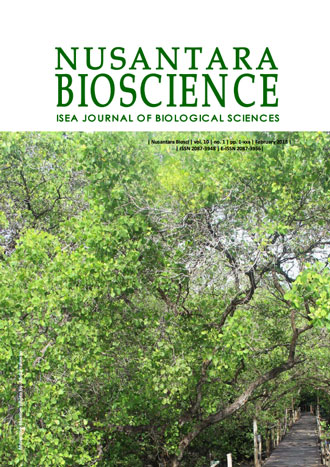Short Communication: Perception of synthetic biology application for biodiversity conservation among life science students in Institut Teknologi Bandung, Indonesia
##plugins.themes.bootstrap3.article.main##
Abstract
Kemal RA. 2018. Short Communication: Perception of synthetic biology application for biodiversity conservation among life science students in Institut Teknologi Bandung, Indonesia. Nusantara Bioscience 10: 35-39. The emerging science of synthetic biology uses advanced engineering and biological science to re-design living organisms to carry out a specific function. Its application to biodiversity conservation seems promising yet barely addressed. Public perception of any emerging sciences and technologies should be studied. Therefore, this pilot study sought insight into the public perception of synthetic biology application to biodiversity conservation. As a pilot study, a web-based survey was designed for life science students in Institut Teknologi Bandung, Indonesia. Obtained responses were exported into Microsoft Excel and analyzed using SPSS 16.0. Results showed that respondents had a high agreement (>75%) on biodiversity problems, but the attitude toward risk in tackling problems is more cautious yet still open to new conservation technology. The respondents' overall perception of synthetic biology application for biodiversity conservation was positive (70% agreed/strongly agreed). The respondents perceived the application as risky but at the same time beneficial. There was a significant correlation between support for new technology development for biodiversity conservation with belief in promises that synthetic biology application's benefit (0.549, p<0.001). The respondents were still optimistic that the application would not decrease people's interest in biodiversity conservation. Results from this pilot study can serve as starting point for discussions and assessments of synthetic biology application in biodiversity conservation.
2019-01-01
##plugins.themes.bootstrap3.article.details##
conservation of nature. Ambio 44 (Suppl. 4): S661-S673.
Bednar-Friedl B, Buijs A, Dobrovodská M, et al. 2009. A long-term
biodiversity, ecosystem, and awareness research network-results from
a (pilot) survey in 8 European countries. Project no. GOCE-CT-2003-
505298 ALTER-Net. Macaulay Land Use Institute, Alterra, UBA.
Buijs AE, Fischer A, Rink D, Young JC. 2008. Looking beyond
superficial knowledge gaps: understanding public representations of
biodiversity. Intl J Biodivers Sci Manag 4: 65-80.
Hagen K, Engelhard M, Toepfer G. 2015. Ambivalences of Creating Life:
Societal and Philosophical Dimensions of Synthetic Biology.
Springer International Publishing, Berlin.
Hendry D. 2016. Empat tahun penjara, hadiah untuk pembunuh harimau
Sumatera. http://www.mongabay.co.id/2016/06/23/empat-tahunpenjara-hadiah-untuk-pemburu-harimau-sumatera/
Khalil AS, Collins JJ. 2010. Synthetic biology: applications come of age.
Nat Rev Genet 11: 367-379.
Kronberger N, Holtz P, Wagner W. 2012. Consequences of media
information uptake and deliberation: focus groups’ symbolic coping
with synthetic biology. Public Underst Sci 21 (2): 174-187.
Kumar S. 2012. Extinction need not be forever. Nature 492: 9.
Novacek MJ. 2008. Engaging the public in biodiversity issues. Proc Natl
Acad Sci USA 105 (S1): 11571-11578.
Pardo Avellaneda R, Hagen K. 2016. Synthetic Biology: Public
Perceptions of an Emergent Field. In: Engelhard M (ed) Synthetic
Biology Analysed. Springer International Publishing, Berlin.
Pauwels E. 2013. Public understanding of synthetic biology. BioScience
63 (2): 79-89.
Pauwels E. 2009. Review of quantitative and qualitative studies on U.S.
public perceptions of synthetic biology. Syst Synth Biol 3 (1): 37-46.
Redford KH, Adams WM, Carlson R, Mace GM, Ceccarelli B. 2014.
Synthetic biology and the conservation of biodiversity. Oryx 48 (3):
330-336.
Redford KH, Adams W, Mace GM. 2013. Synthetic biology and
conservation of nature: wicked problems and wicked solutions. PLoS
Biol 11 (4): e1001530. DOI: 10.1371/journal.pbio.1001530.
Ruder WC, Lu T, Collins JJ. 2011. Synthetic biology moving into the
clinic. Science 333: 1248-1252.
Sharp RL, Larson LR, Green GT. 2011. Factors influencing public
preferences for invasive alien species management. Biol Conserv 144:
2097-2104.
Siegrist M. 2010. Predicting the future: Review of public perception
studies of nanotechnology. Hum Ecol Risk Assess 16: 837-846.
Suhandono S. 2017. Synthetic biology: Emerging bioengineering in
Indonesia. AIP Conf Proc 18844: 030001-1-030001-8. DOI:
10.1063/1.4983428
Thamamongood T, Lim NZL, Ho TYH, Ayukawa S, Kiga D, Chow KL.
2013. Cultivation of synthetic biology with the iGEM competition. J
Adv Comput Intell Intell Inform 17 (2): 161-166.
Torgersen H. 2009. Synthetic biology in society: learning from past
experience? Syst Synth Biol 3 (1): 9-17.
Wolfe AK. 2015. Societal aspects of synthetic biology: organisms and
applications matter! J Responsib Innov 2 (1): 121-123.
Xiao C. 2013. Public attitudes toward science and technology and concern
for the environment : testing a model of indirect feedback effects.
Environ Behav 45 (1): 113-137.
Zhang L, He G, Mol APJ, Lu Y. 2013. Public perceptions of
environmental risk in China. J Risk Res 16 (2): 195-209.

